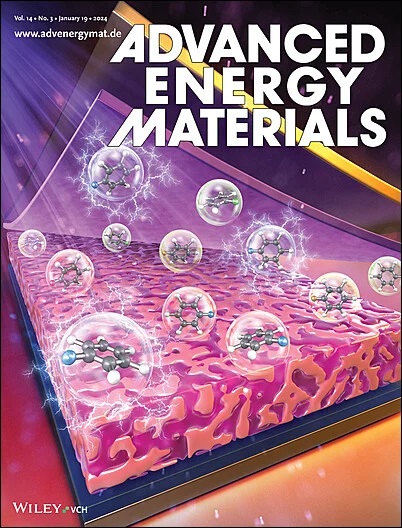Homogeneously Blended Donor and Acceptor AgBiS2 Nanocrystal Inks Enable High‐Performance Eco‐Friendly Solar Cells with Enhanced Carrier Diffusion Length
IF 24.4
1区 材料科学
Q1 CHEMISTRY, PHYSICAL
引用次数: 0
Abstract
Colloidal semiconductor nanocrystals (NCs) have garnered significant attention as promising photovoltaic materials due to their tunable optoelectronic properties enabled by surface chemistry. Among them, AgBiS均匀混合供体和受体AgBiS2纳米晶油墨使高性能生态友好型太阳能电池具有增强的载流子扩散长度
胶体半导体纳米晶体(NCs)由于其表面化学可调的光电特性而成为一种有前途的光伏材料,引起了人们的广泛关注。其中,AgBiS2纳米材料因其环保成分、高吸收系数和低温可加工性而成为太阳能电池应用的一个有吸引力的候选者。然而,与其他基于NC的器件相比,AgBiS2 NC光伏通常表现出较低的功率转换效率(PCE),这主要是由于许多表面陷阱作为重组位点,导致自由载流子的扩散长度较短。为了解决这一挑战,本研究开发了供体和受体混合(D/A) AgBiS2薄膜。通过配体调制,本研究制定了适合电荷分离的受体和供体AgBiS2 NC油墨,同时确保它们在同一溶剂中完全混溶。这使得制造高质量,厚度可控的D/A混合结膜成为可能。这项工作发现,这种方法有效地促进了载流子分离,从而提高了载流子寿命和扩散长度。因此,使用这种方法,这项工作在太阳能电池应用中实现了比传统器件厚两倍的AgBiS2薄膜,从而提高了电流密度和太阳能电池的PCE为8.26%。
本文章由计算机程序翻译,如有差异,请以英文原文为准。
求助全文
约1分钟内获得全文
求助全文
来源期刊

Advanced Energy Materials
CHEMISTRY, PHYSICAL-ENERGY & FUELS
CiteScore
41.90
自引率
4.00%
发文量
889
审稿时长
1.4 months
期刊介绍:
Established in 2011, Advanced Energy Materials is an international, interdisciplinary, English-language journal that focuses on materials used in energy harvesting, conversion, and storage. It is regarded as a top-quality journal alongside Advanced Materials, Advanced Functional Materials, and Small.
With a 2022 Impact Factor of 27.8, Advanced Energy Materials is considered a prime source for the best energy-related research. The journal covers a wide range of topics in energy-related research, including organic and inorganic photovoltaics, batteries and supercapacitors, fuel cells, hydrogen generation and storage, thermoelectrics, water splitting and photocatalysis, solar fuels and thermosolar power, magnetocalorics, and piezoelectronics.
The readership of Advanced Energy Materials includes materials scientists, chemists, physicists, and engineers in both academia and industry. The journal is indexed in various databases and collections, such as Advanced Technologies & Aerospace Database, FIZ Karlsruhe, INSPEC (IET), Science Citation Index Expanded, Technology Collection, and Web of Science, among others.
 求助内容:
求助内容: 应助结果提醒方式:
应助结果提醒方式:


